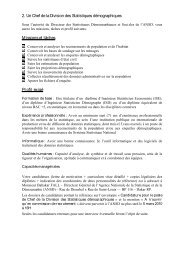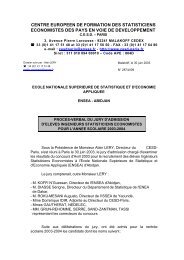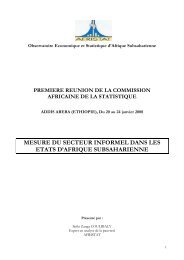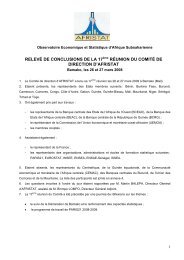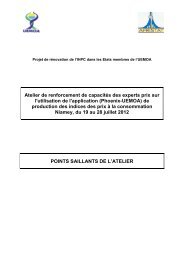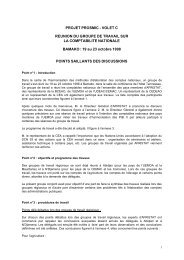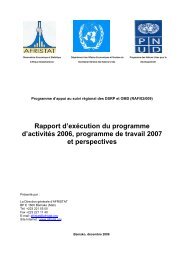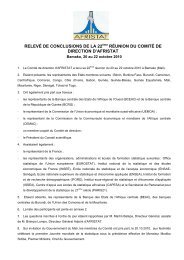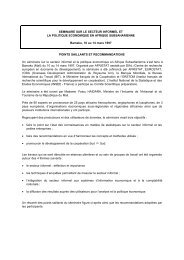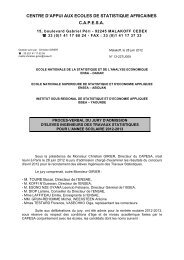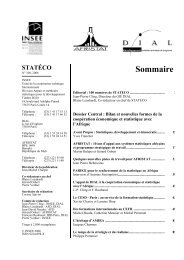Global Purchasing Power Parities and Real Expenditures - Afristat
Global Purchasing Power Parities and Real Expenditures - Afristat
Global Purchasing Power Parities and Real Expenditures - Afristat
Create successful ePaper yourself
Turn your PDF publications into a flip-book with our unique Google optimized e-Paper software.
IntroductionThe 2005 PPPs are derived from a global program of pricesurveys carried out using similar methods in 146 economies.The previous benchmark estimates were based on surveyscarried out between 1993 <strong>and</strong> 1996 in a limited numberof developing economies <strong>and</strong> on more recent surveys inOECD <strong>and</strong> CIS economies conducted in 2002 <strong>and</strong> 2000,respectively. Many economies were included for the firsttime in 2005, including China. Previous estimates of China’sPPPs came from a research study using data for 1986.India participated for the first time since 1985. Because ofthe old vintage of Indian data, a regression was used insteadfor the PPP estimate in the WDI (for the methodology, see“Estimation of PPPs for nonbenchmark economies”). Sincethe last round of price collections, PPPs have been extrapolatedforward using ratios of price indexes (either GDPdeflators or consumer price indexes). In addition, the new2005 PPPs are based on a different methodology designedto overcome problems encountered in previous rounds ofthe ICP. Therefore, users should be cautious about makingcomparisons with previous estimates of PPP-based GDP<strong>and</strong> components. What can be said is that the new ICPresults substantially revise our view of the world economy.(Additional detail about the comparability with previousestimates is contained in appendix G.)The overall ICP was designed <strong>and</strong> conducted to providecomparable results between economies across differentregions. However, because of the difficulties of measuringhousing <strong>and</strong> government compensation, different methodswere used to compute housing PPPs in Asia-Pacific <strong>and</strong>Africa <strong>and</strong> government PPPs in Asia-Pacific, Africa, <strong>and</strong>Western Asia from those used in the other regions.(Appendixes F <strong>and</strong> G provide a detailed overview of themethodological differences that may affect comparabilityof the new results with those from the past, as well as comparisonsbetween regions.)PPPs provide a measure of the overall price level of aneconomy, but they may not reflect the expenditure patternsof the poor. Nor do they capture differences in pricelevels within an economy. Additional data <strong>and</strong> analysis willbe necessary before international poverty rates can be estimated;direct application of these PPPs to the estimation ofpoverty levels <strong>and</strong> rates may yield misleading results.Box 1Estimating PPPs for largeeconomiesObtaining national prices for a list of comparable productsposes special problems for large, diverse economies <strong>and</strong> especiallythose with large, rural populations. The sample sizes <strong>and</strong>number of data collection centers required to collect the dataneeded to estimate national average prices exceed the capacityeven of advanced economies. Eurostat economies, for example,collect prices only in urban areas <strong>and</strong> use other sources to adjustthese to the national level. In the case of China, it was agreedthat China would collect prices for 11 municipalities, includingtheir surrounding rural areas, <strong>and</strong> that the World Bank <strong>and</strong>the Asian Development Bank (ADB) would extrapolate theseto national average prices. The method adopted by the WorldBank <strong>and</strong> ADB matched urban <strong>and</strong> rural areas of the 11 municipalitiesto the 31 provinces of China. However, the ruralareas included in the surveys may not have been representativeof those in the rest of China. See appendix E, which provides amore detailed explanation.The overrepresentation of urban areas was not unique toChina. Brazil, for example, collected prices in only 6 cities.Other economies in the South America region conducted pricecollection in urban areas only. Because PPPs are based on a multilateralcomparison within each region, biases in data collectionshould largely cancel out if all economies within a regionare similarly treated. In the Asia-Pacific region, the extent ofurban bias in China’s PPP measurements will depend on howdifferent were its data collection procedures—<strong>and</strong> the resultingcomputation of national average prices—compared with thoseof other economies in its region. India, for example, collectedboth urban <strong>and</strong> rural prices for food, clothing, footwear, <strong>and</strong>education. Prices for all other components of the GDP werecollected in 31 urban centers. However, because most goodsother than food are produced <strong>and</strong> purchased in the cities, theurban prices of those goods can be considered representativeof the national prices. Further sensitivity analysis of the resultswill be needed to quantify the extent of this bias, if any.



